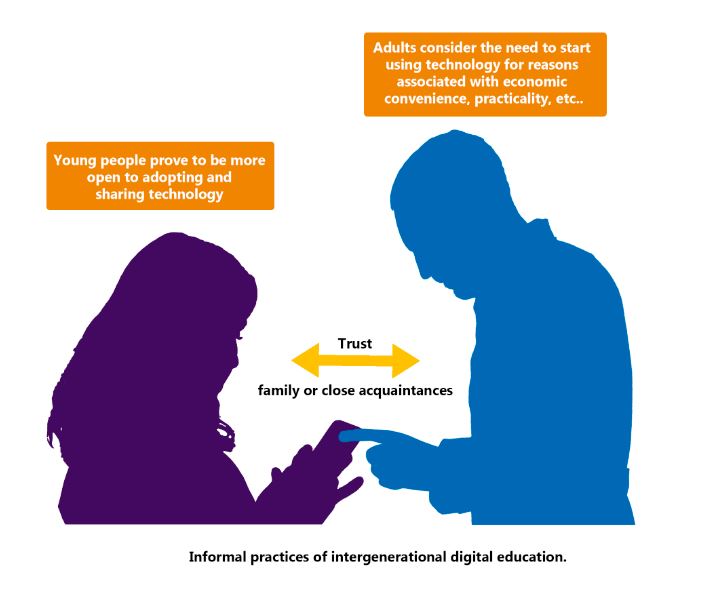Disclaimer:
Please be aware that the content herein is comprised of personal reflections, observations, and insights from our contributors. It is not necessarily exhaustive or authoritative, but rather reflects individual perspectives. While we aim for accuracy, we cannot guarantee the completeness or up-to-date nature of the content.
The digital transition accelerated by the pandemic introduce an extended use of digital payments, transactions, and procedures. When faced with this, many people from low-income neighborhoods, especially the elderly, struggled and turn to their families, friends, and community to learn how to navigate these new mechanisms. Young people tend to feel more confident than adults when using cell phones, at least in handling certain basic experiences. Hence, many of them develop extended and informal practices of intergenerational digital education. For example, these trainings can be useful for adopting new features and/or payment platforms (for example, to pay for transportation), banks or digital wallets, among others. This symbolizes a real financial inclusion, given the extended use of these mechanisms nowadays. Young people regularly prove to be more open to adopting and sharing technology. On the other hand, adults may be curious about it for reasons associated with economic convenience, practicality, etc., or they may eventually consider the need to start using it. In addition to the interest or curiosity detected, the fear of falling into debt mechanisms in digital platforms is also recognized. Several testimonies collected in the mapping “Close up: Financial Inclusion and Grassroots Solutions” refer to experiences of older adults in this regard. Because of this, this informal training: i) is first limited to family members or close acquaintances; and ii) promotes confidence in the use of the cell phone and in the digital platforms to be adopted. This trust is associated with the person (a young acquaintance) who has already been operating in the virtual world and identifies actual benefits (better price, good service, or others). Furthermore, the women interviewed for “Mujeres en Red” (Women in Network) made it clear that the decision to install this type of application is often done simultaneously with the process of learning how to use it, usually with help from family members and/or close people who accompanied the process and act as trainers. However, there was evidence of a lack of institutional communicators/trainers in a formalized and systematic way. Such is their importance that it is impossible to use technology in the absence of a self-teaching predisposition or a person close to them who can guide its use , and the barriers that are in place cannot be overcome. Finally, it is important to remember that widespread access to cell phones does not imply a high level of confidence in their use, nor overcoming the problems associated with data use at the base of the pyramid. Additionally, to facilitate these trainings and encourage the use of these new mechanisms, the lack of internet connectivity is a real problem in low-income neighborhoods. To face this problem, social organizations that already offered training also pay for Wi-Fi to attract and retain young people, so that they do not spend their time on the street. There, they share their time with people of different ages with whom they could share their knowledge.

https://www.undp.org/es/argentina/publications/mujeres-en-red-soluciones-financieras-y-de-recuperacion-socioeconomica<div><br></div> https://www.undp.org/es/argentina/publications/busqueda-compartida-mapeo-de-soluciones-colaborativo-inclusion-financiera-y-recuperacion-economica
https://www.undp.org/es/argentina/publications/de-cerca-inclusion-financiera-y-soluciones-territoriales
 Consent to share form or official link.
Consent to share form or official link.

 1No poverty
1No poverty 5Gender equality
5Gender equality 10Reduced innequalities
10Reduced innequalities 17Partnerships for the goals
17Partnerships for the goals
Comments
Log in to add a comment or reply.